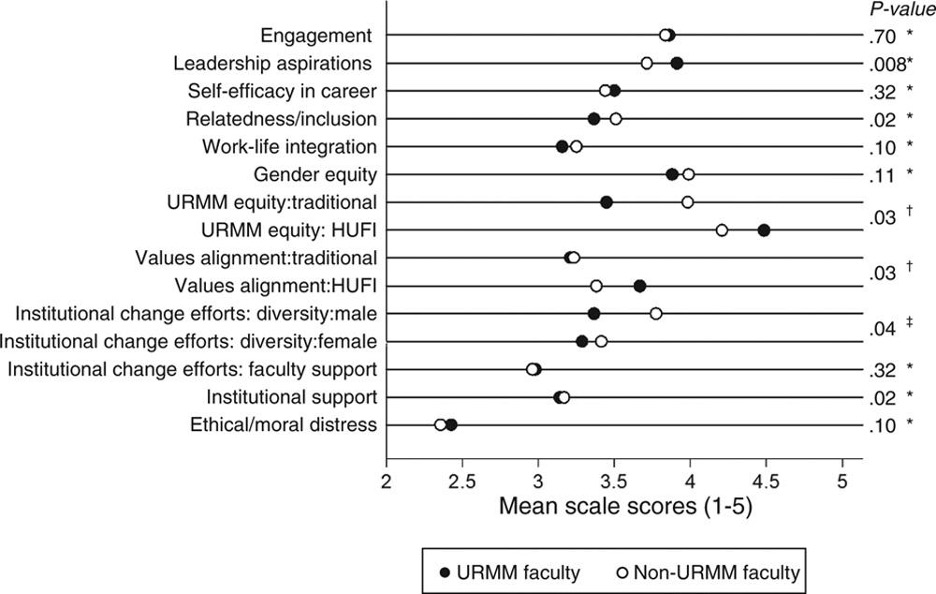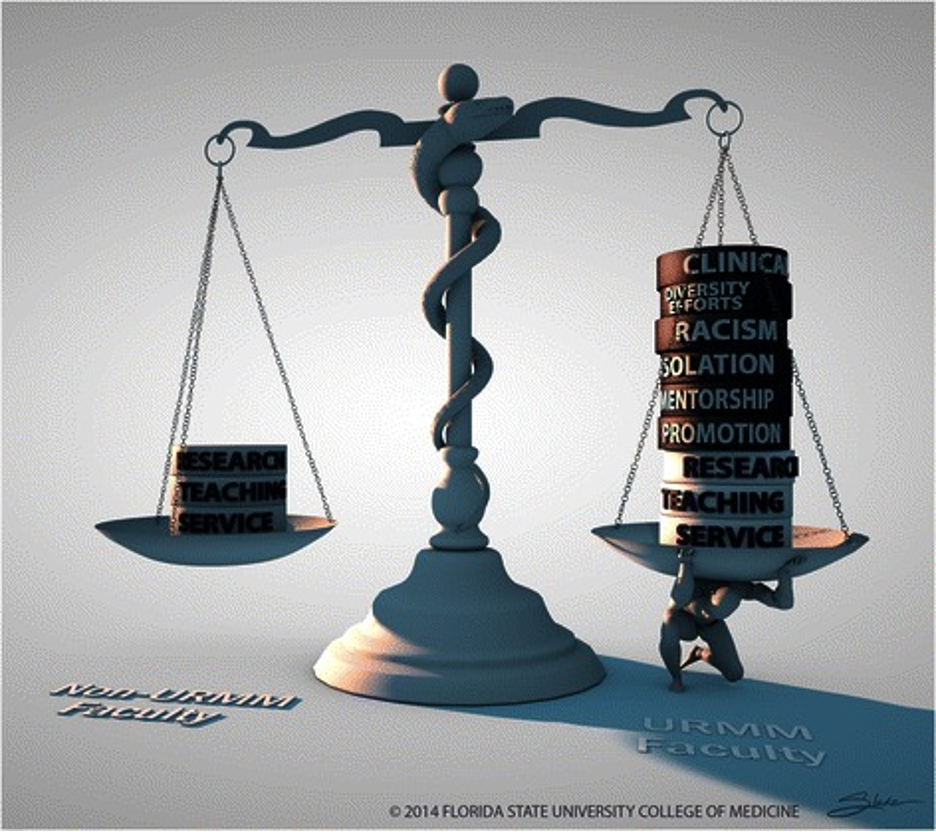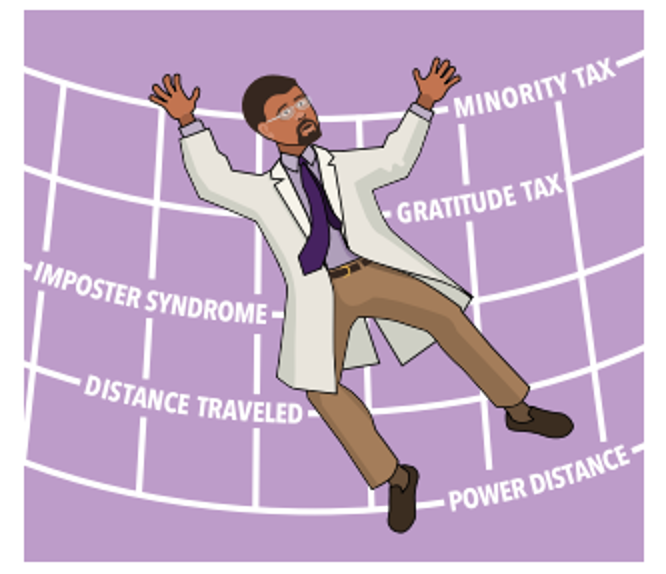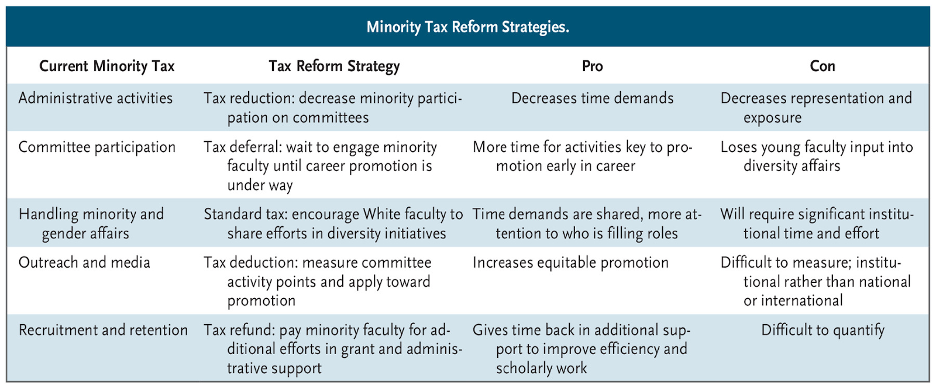
Minority Tax, Gratitude Tax, Emotional Tax
Burdens of Underrepresented Doctors of Academic Medicine: Minority Tax, Gratitude Tax, Emotional Tax
Author: Rebecca Goett, MD
Editor: Pooja Agrawal, MD, MPH
Definition(s) of Terms
Starting with a common understanding of key words, phrases, and potentially misunderstood related terms in DEI discussions helps ensure that all participants feel informed and welcome to participate in the discussion. Some terms have multiple definitions provided to help highlight nuances in the definitions.
Minority Tax: Underrepresented Minority in Medicine (URMM) doctors are given increased responsibilities in recruitment, mentorship or other diversity efforts. This disparity is evident in many areas: diversity efforts, racism, isolation, mentorship, clinical responsibilities, and promotion. (1)
Minority Tax: Feeling of being treated as a token, as a person whose value is minimal to the organization, is pervasive across disciplines and demographics. (2)
Gratitude Tax: the feeling of obligation that URMM faculty have to the academic institution and to future generations of URMMs for being given the opportunity to be a physician. This newly described nuance to the minority tax affects both inner decision-making processes and personal ambitions. (3)
Gratitude Tax: Describes the expectation that URMM faculty forgo promotion or advancement at another institutions out of a sense of obligation to their current institution. (4)
Emotional Tax: the emotional toll of defending or explaining one’s underrepresented history, identity, and culture to non-underrepresented colleagues (2)
Synonyms/Related Terms
This section highlights the definitions of other words that may be used in discussion of this topic. Sometimes these words can be used interchangeably with the terms defined above, and sometimes they may have been used interchangeably historically, but have distinct meanings in DEI conversations that it is helpful to recognize.
For Minority Tax: “Cultural tax” (1) or “Black tax,” (4)
For Gratitude Tax: “Loyalty tax” (4)
Scaling This Resource: Recommended Use
As many users may have varying amounts of time to present this material, the authors have recommended which resources they would use with different timeframes for the presentation.
1 minute presentation: definitions
10-15 minute presentation: definitions, short video, followed by brainstorming how to overcome these “taxes” or obstacles
30 minute presentation: definitions, small group discussions reflecting on past experiences or videos, followed by brainstorming how to overcome these “taxes” or obstaclesDiscussion/Background
This section provides an overview of this topic so that an educator who is not deeply familiar with it can understand the basic concepts in enough detail to introduce and facilitate a discussion on the topic. This introduction covers the importance of this topic as well as relevant historical background.
Background:
Underrepresented minorities in medicine (URMM) continue to be underrepresented in academics. The American Medical Association (AMA), the American Association of Medical Colleges (AAMC) and the National Medical Association (NMA) have been working to increase the representation of underrepresented minorities in medicine (URMM). (1) The proportion of Black, Latino, and Native American faculty in U.S. academic medical centers increased slightly over the last 20 years (7% vs. 8%) (5); however, the proportions of URMM faculty and URMM students remain unchanged since the numbers of positions has increased. (5)
In addition, URM (underrepresented minority) faculty have higher attrition and lower promotion rates even after controlling for achievement 6. Based on AAMC faculty databases, the median institution-specific promotion rates for White, Hispanic, and Black faculty, respectively, were 30.2%, 23.5%, and 18.8% (P < .01) from assistant to associate professor and 31.5%, 25.0%, and 16.7% (P < .01) from associate to full professor. Promotion rates for Hispanic and Black faculty were found to be lower than those for White faculty at academic medical centers 6,7. Another study found that when compared with non-URMM faculty, URMM faculty report higher leadership aspirations but lower perceptions of relationships/inclusion, gave their institutions lower scores on URMM equity and institutional efforts to improve diversity, and more frequently engaged in disparities research. (8) National efforts have been made to recruit URM faculty. Efforts to understand the ongoing inequality in recruitment and promotion of URM faculty need to also be explored.
Discussion:
Why is this URM representation still below national goals? And why are URM faculty at lower appointed positions than their non-URM colleagues?
Definitions
Some partially contribute this to the "minority tax", a burden of extra responsibilities placed on URMM faculty including diversity recruiting, institutional efforts to fight racism, and mentoring in addition to their clinical duties. Often these additional diversity duties do not count as scholarship or assisting promotion for these faculty members.
In addition, these diversity activities are frequently uncompensated or undervalued. They may not allow dedicated time off for clinical duties, and are not shared equally by all faculty. They tend to disproportionately burden URMM faculty. (1) By increasing their workload, URMM are affected both personally and professionally. This tax is a complex source of inequity in academic medicine.
Professional Effects
Minority tax needs to be acknowledged as a burden for URMM faculty that leads to delays in advancement, isolation, and personal stress. An offshoot of the minority tax is the gratitude tax. ‘Gratitude tax’ is when academic burdens or disparities lead URMM faculty to change personal or behavior patterns. Staying in a position out of a sense of loyalty, for example. It is also the feeling that URMM faculty must dedicate more time than one’s peers because of being given the chance or opportunity for employment.
The ‘Gratitude tax’ is a feeling of indebtedness to an institution, which can diminish one’s sense of accomplishment and encourage the need to pay back their perceived debt (3), potentially stunting academic growth. They often stay at their institution or fail to seek better opportunities for professional advancement elsewhere. (3)
Personal Effects
Another stressor for URMM is termed ‘Emotional tax’ or the need for URM to justify their position or work. This feeling of being treated as a token, as a person whose value is minimal to the organization, is pervasive across disciplines and demographics. (2) The ‘emotional tax’ challenges URMM faculty to prove themselves worthy of their professional positions through their experiences, identities, and cultures. However, when faculty feel their experiences could benefit their institutions in leadership or administration decisions, they're not called upon to share their knowledge leading to a decreased sense of value. (2)
Solutions:
Addressing these disparities requires political stamina, negotiation and coalition building. (1) Diversifying academic leadership can help alleviate the URMM responsibility disparity. Often, a champion already in academic leadership is needed who is willing to use political capital to establish faculty equity. In addition to starting institutional change programs such as adding scholarship value to diversity outreach or URMM promotion and retention programs, further research on these interventions addressing the URMM faculty responsibility disparity is also necessary. These interventions, once implemented, can hopefully help create a healthy, diverse, and inclusive environment that will benefit all members of the academic community and improve health care. (1)Quantitative Analysis/Statistics of note
This section highlights the objective data available for this topic, which can be helpful to include to balance qualitative or persuasive analysis or to help define a starting point for discussion.
Using Association of American Medical College's (AAMC) 1983 through 2000 faculty roster data, promotion rates between racial/ethnic groups at 128 academic medical centers with 88, 432 unique faculty. The median institution-specific promotion rates for White, Hispanic, and Black faculty, respectively, were 30.2%, 23.5%, and 18.8% (P < .01) from assistant to associate professor and 31.5%, 25.0%, and 16.7% (P < .01) from associate to full professor.

In 2007-2009, of a random sample of 2,381 MD and PhD full-time faculty from 26 U.S. medical schools' faculty: 512 (23%) were URMM, and 1,172 (53%) were female, mean age 49 years. (8)
- Compared with non-URMM faculty, URMM faculty endorsed higher leadership aspirations but reported lower perceptions of relationships/inclusion, gave their institutions lower scores on URMM equity and institutional efforts to improve diversity, and more frequently engaged in disparities research. (8)
- 22% (115) had experienced racial/ethnic discrimination. (8)
 (8)
(8)
Slide Presentation or Images
Images and graphical representations in presentations can clarify concepts and enhance interest. Please cite the sources of these images appropriately if you use them in your presentation, found in the last section of this page. We purposefully avoided providing complete slide decks in this curriculum, and instead opted to offer easy building blocks for a great personalized presentation regardless of the format.
 (1)
(1)
 (4)
(4)
 (9)
(9)
Role-playing Scenario
Role-playing scenarios can enhance investment and participation. Always consider psychological safety when asking participants to engage in any role-playing activity to avoid potential adverse effects. We highly recommend a discussion for each group to agree on ground rules of respectful learning prior to engaging in any role-playing scenarios (embrace ambiguity, commit to learning together, listen actively, create a brave space, suspend judgment, etc.). It is reasonable to review these ground rules prior to each role-playing discussion.
Minority Tax/ Emotional Tax Example Cases:
Case #1:
Two faculty members are at a faculty meeting. One faculty identifies as an underrepresented minority in medicine, while the other faculty identifies as white. The underrepresented faculty notices that during group discussions regarding signing up for diversity and URM mentorship activities, significantly more eye contact is made with them than white faculty.
Case #2:
A Black woman faculty has just joined the department. Feeling overwhelmed with learning the new environment, she declined an invitation to serve on a diversity committee, a white colleague jokes at faculty meeting “Why did we let you in, then?” (12)
Case #3:
Barriers/Challenges/Controversies
This section should help the facilitator anticipate any questions, naysayers, rebuttals, or other feedback they may encounter when presenting the topic and allow preparation with thoughtful responses. Facilitators may experience concerns about their personal ability to present a specific DEI topic (ie a white facilitator presenting on anti-racism or minority tax), and this section may address some of those tensions.
One suggested solution to minority tax, is for non-URM faculty to be “taxed more” which is likely to be unwelcomed. When minorities pay more tax to improve diversity initiatives, white faculty are taxed less. To balance the tax burden, White faculty should be encouraged to take on more roles in diversity initiatives. A standardized tax would prod White faculty to answer the call to engage in antiracism movements. Greater engagement of White faculty would change the perception of diversity work, supporting the importance of these endeavors. Including all faculty in the candidate pools for leadership positions in both diversity-related and other initiatives might also result in more minority faculty taking on non–diversity-related leadership roles. Sharing responsibilities also means sharing time demands, offering relief that’s essential — there is no substitute for protected time when it comes to promotion. Of course, applying standard taxation would take substantial time and institutional effort to already stressed academia faculty. (9 & 10)
Ethical Issues
This section may be useful to hospital ethics committees who want to increase their DEI awareness as part of monthly meetings, or to other groups who are interested in the ethical underpinnings of the topic.
- Respect for Others
- Justice
Opportunities
Sometimes DEI topics can present depressing history and statistics. This section highlights glimmers of hope for the future: exciting projects, areas of study inspired by the topic, or even ironic twists where progress has emerged or may be anticipated in the future.
Value diversity effort fairly
- Recognize that the URMM responsibility disparity exists and adjust assignment of responsibilities accordingly
- Work to ensure that clinical and community endeavors are counted toward promotion
- Assign promotion value to work in the area of diversity
- Employ rules that are in harmony with the institution’s stated service goals and mission
- Increase awareness and avoidance of mission drift, i.e., institutional departure from the service mission
- Fund stated institutional diversity commitments.
Eliminate all forms of discrimination
- Institute policies and procedures that address and correct bias
- Move beyond compliance with the Americans with Disabilities Act and Title VII to establish robust accountability systems for acts of discrimination by including it in annual evaluations.
Facilitate and support relationship formation among faculty, administrators, and learners
- Encourage positive curiosity when encountering “otherness” and recognize differences in faculty as benefitting our institutions
- Seek training in unconscious bias for all faculty to help recognize its role in discrimination.
Ensure clear, frank, honest communication between administration and faculty to avoid faculty discouragement.
- Develop transparent communication in the promotion and tenure process.
- Develop opportunities for explicit conversations (i.e. professionally moderated retreats) about personal values to amplify the meaning faculty find in the practice of medicine and in their careers
Develop an employee retention strategy
This could take the form of faculty development that focuses on:
- Institutional culture
- Networking
- Professional skill development
- Understanding the prevalence and acceptance of unconscious bias
- Teaching acceptable institution specific behaviors to address silent racism.
- Dealing with micro-aggressions and stereotype threat
- Avoiding isolation and marginalization
- Mentoring
Journal Club Article links
A journal club facilitator can access several salient publications on this topic below. Alternatively, an article can be distributed ahead of a presentation to prompt discussion or to provide a common background of understanding. Descriptions and links to articles are provided.
Rodríguez, J.E., Campbell, K.M. & Pololi, L.H. Addressing disparities in academic medicine: what of the minority tax? BMC Med Educ 15, 6 (2015). https://doi.org/10.1186/s12909-015-0290-9
- This article offers a good overall summary of issues surrounding Minority Tax and often is the most cited in other articles, good introduction1.
Boatright D, Branzetti J, Duong D, et al. Racial and Ethnic Diversity in Academic Emergency Medicine: How Far Have We Come? Next Steps for the Future. AEM Educ Train. 2018;2(Suppl Suppl 1):S31-S39. Published 2018 Dec 3. doi:10.1002/aet2.10204
- EM specific article that offers ways to overcome barriers. (11)
Discussion Questions
The questions below could start a meaningful discussion in a group of EM physicians on this topic. Consider brainstorming follow-up questions as well.
- What are the barriers you have encountered to being a resident or faculty member?
- What concrete ways can we brainstorm to make changes to help overcome these taxes?
Summary/Take-home Themes
The authors summarize their key points for this topic below. This could be useful to create a presentation closing.
- Medical schools have a continued lack of diversity. URM faculty are often pressured to do activities such as diversity recruitments, efforts to fight racism and mentorship in addition to their clinical duties.
- Minority tax needs to be widely acknowledged as a proven burden for URM faculty that leads to delays in advancement, isolation, and personal stress. Emotional tax, the need for URM justify their position or work, add also to this stress.
- These burdens or disparities lead faculty to make personal and behavior patterns such as gratitude tax, staying at a position out of a sense of loyalty. Change is necessary which means an even distribution of the ‘tax’ to all faculty.
Relevant Quotations
Meaningful and relevant quotations (appropriately attributed) can be used to enhance presentations on this topic.
- “The cost of being a woman in a procedural medical field is hefty in academia, and when amplified by being Black, the cost can be incredible to bear.” - Sophie Balzora (13)
- “I believed that considering other institutions was a betrayal of those generous enough to give me my first academic positions. This idea may have been subtly reinforced by leaders in an effort to discourage me from leaving. Gratitude, however, does not mean sacrificing your career; it means positioning yourself where you can do the most good.” (3)
- “I am very much a researcher, but until recently, I was more known at Hopkins as a person who does work around diversity than around my science. In some ways, that troubled me.”
- “Everyone should be a champion of diversity efforts,” she says. “If an institution truly believes that diversity, equity and inclusion are important and lead to excellence, it needs to be reflected in its promotion and tenure process.” (14)
Specialty Resource Links
Below is a link to an Emergency Medicine-specific resource for this topic.
DEI Resource Library: Evidence of Exclusion in Academic Medicine. SAEM. https://www.saem.org/about-saem/academies/adiemnew/resources/dei-resource-library/evidence-of-exclusion-in-academic-medicine. Last Accessed January 18th, 2022. (15)
Community Resource Links
Below is a link to an educational resource or supportive program in the community that is working on this topic.
Beyond Recruitment. Race & Medicine. https://www.raceandmedicine.com/beyond-recruitment. Last Accessed January 18th, 2022. (16)
Video Links
Below are links to videos that do an excellent job of explaining or discussing this topic. Short clips could be used during a presentation to spark discussion, or links can be assigned as pre-work or sent out for further reflection after a presentation.
- Video: Finding a Cure - Chantel Thompson - The Minority Tax. https://www.youtube.com/watch?v=JeQvgjs6i6U. 1 minute summary of What Minority Tax is. Last Accessed January 23rd, 2022. (17)
- Podcast: Interview with Dr. Theresa Williamson on Strategies for Reducing the Burden of the Minority Tax in Academic Medicine. N Engl J Med 2021;384:1877-1879. Released: May 19, 2021. (https://www.nejm.org/action/showMediaPlayer?doi=10.1056%2FNEJMdo006057&aid=10.1056%2FNEJMp2100179&area=) Last Accessed January 23rd, 2022. (18)
Quiz Questions/Answers
Possible questions and an answer key are provided below. These can be useful to document effectiveness in learning and knowledge gained but can also be useful to help learners identify that they may not actually know everything about a DEI topic, even if they have participated in presentations on it previously.
- Minority tax will lead to faster promotion due to increased academia activities in diversity recruitment, mentoring, etc. T/F?
- Emotional tax is feeling the need to justify your presence and position. T/F?
- Emotional tax can be a consequence of microaggressions against URM T/F?
Answer Key
- F. Minority tax increased burdens for URM faculty but often those activities do not count towards promotions or scholarship necessary for promotion.
- T. Emotional tax is the feeling of the need to justify your presence and position that you deserve to be in your position (not a mere token).
- T. Microaggressions against URM can cause the faculty to feel of less value and led them to justify themselves.
Call to Action Prompt
Below is a statement that inspires participants to commit to meaningful action related to this topic in their own lives. This could be used to prompt reflection, discussion, or could be used in a presentation closing.
We pledge to promote diversity and to better represent our community by recruiting URM faculty, but then these URM faculty have increased burdens. How can we overcome these “taxes”? Has this discussion prompted ideas of how we can better support other faculty? What commitment can you make that you will act on this month? How will you remind yourself to follow through on that commitment? (Text self, make calendar appointment to reflect once per week, etc)
References
All references mentioned in the above sections are cited sequentially here.
- Rodríguez JE, Campbell KM, Pololi LH. Addressing disparities in academic medicine: what of the minority tax? BMC Med Educ. 2015 Feb 1;15:6. doi: 10.1186/s12909-015-0290-9. PMID: 25638211; PMCID: PMC4331175.
- Reed AM. The Emotional Tax of Deficit Thinking. Stanford Social Innovation Review. 2021. doi.org/10.48558/PTYH-3C50
- Campbell KM, Rodríguez JE. Addressing the Minority Tax: Perspectives from Two Diversity Leaders on Building Minority Faculty Success in Academic Medicine. Acad Med. 2019 Dec;94(12):1854-1857. doi: 10.1097/ACM.0000000000002839. PMID: 31192803.
- Campbell, K.M., Hudson, B.D. & Tumin, D. Releasing the Net to Promote Minority Faculty Success in Academic Medicine. J. Racial and Ethnic Health Disparities 7, 202–206 (2020). https://doi.org/10.1007/s40615-020-00703-z
- Guevara J, Adanga E, Avakame E, Carthon M. Minority Faculty Development Programs and Underrepresented Minority Faculty Representation at US Medical Schools. JAMA. 2013;310(21):8.
- Nunez-Smith, M., Ciarleglio, M. M., Sandoval-Schaefer, T., Elumn, J., Castillo-Page, L., Peduzzi, P., & Bradley, E. H. (2012). Institutional variation in the promotion of racial/ethnic minority faculty at US medical schools. American Journal of Public Health. 102(5), 852–858. https://doi.org/10.2105/AJPH.2011.300552
- Data & Reports: Diversity and Inclusion: Diversity in Medicine: Facts and Figures 2019. Association of American Medical Colleges (AAMC). https://www.aamc.org/data-reports/workforce/interactive-data/figure-17-percentage-full-time-us-medical-school-faculty-sex-race/ethnicity-and-rank-2018. Last Accessed January 23, 2022.
- Pololi, L. H., Evans, A. T., Gibbs, B. K., Krupat, E., Brennan, R. T., & Civian, J. T. (2013). The experience of minority faculty who are underrepresented in medicine, at 26 representative U.S. medical schools. Academic medicine: journal of the Association of American Medical Colleges, 88(9), 1308–1314. https://doi.org/10.1097/ACM.0b013e31829eefff
- Williamson, T., Goodwin, C. R., & Ubel, P. A. (2021). Minority Tax Reform - Avoiding Overtaxing Minorities When We Need Them Most. The New England journal of medicine, 384(20), 1877–1879. https://doi.org/10.1056/NEJMp2100179
- Foster KE, Johnson CN, Carvajal DN, et al. Dear White People. Ann Fam Med. 2021;19(1):66-69. doi:10.1370/afm.2634
- Boatright D, Branzetti J, Duong D, et al. Racial and Ethnic Diversity in Academic Emergency Medicine: How Far Have We Come? Next Steps for the Future. AEM Educ Train. 2018;2(Suppl Suppl 1):S31-S39. Published 2018 Dec 3. doi:10.1002/aet2.10204
- Bumpus N. Too Many Senior White Academics Still Resist Recognizing Racism. Nature. 2020 Jul;583(7818):661. doi: 10.1038/d41586-020-02203-w. PMID: 32724148.
- Balzora S. When the minority tax is doubled: being Black and female in academic medicine. Nat Rev Gastroenterol Hepatol. 2021 Jan;18(1):1. doi: 10.1038/s41575-020-00369-2. PMID: 32963339.
- Nitkin K. The ‘Majority Subsidy’: What happens when a few faculty members are tasked with taking on most of the work of building diversity and inclusion? Hopkins Medicine Magazine: Winter 2020. Feb 7, 2020. https://www.hopkinsmedicine.org/news/articles/the-majority-subsidy. Last Accessed January 23, 2022.
- DEI Resource Library: Evidence of Exclusion in Academic Medicine. SAEM. https://www.saem.org/about-saem/academies/adiemnew/resources/dei-resource-library/evidence-of-exclusion-in-academic-medicine. Last Accessed January 18th, 2022.
- Beyond Recruitment. Race & Medicine. https://www.raceandmedicine.com/beyond-recruitment. Last Accessed January 18th, 2022.
- Video: Finding a Cure - Chantel Thompson - The Minority Tax. https://www.youtube.com/watch?v=JeQvgjs6i6U. 1 minute summary of What Minority Tax is. Last Accessed January 23rd, 2022.17
- Podcast: Interview with Dr. Theresa Williamson on Strategies for Reducing the Burden of the Minority Tax in Academic Medicine. N Engl J Med 2021;384:1877-1879. Released: May 19, 2021. (https://www.nejm.org/action/showMediaPlayer?doi=10.1056%2FNEJMdo006057&aid=10.1056%2FNEJMp2100179&area=) Last Accessed January 23rd, 2022
